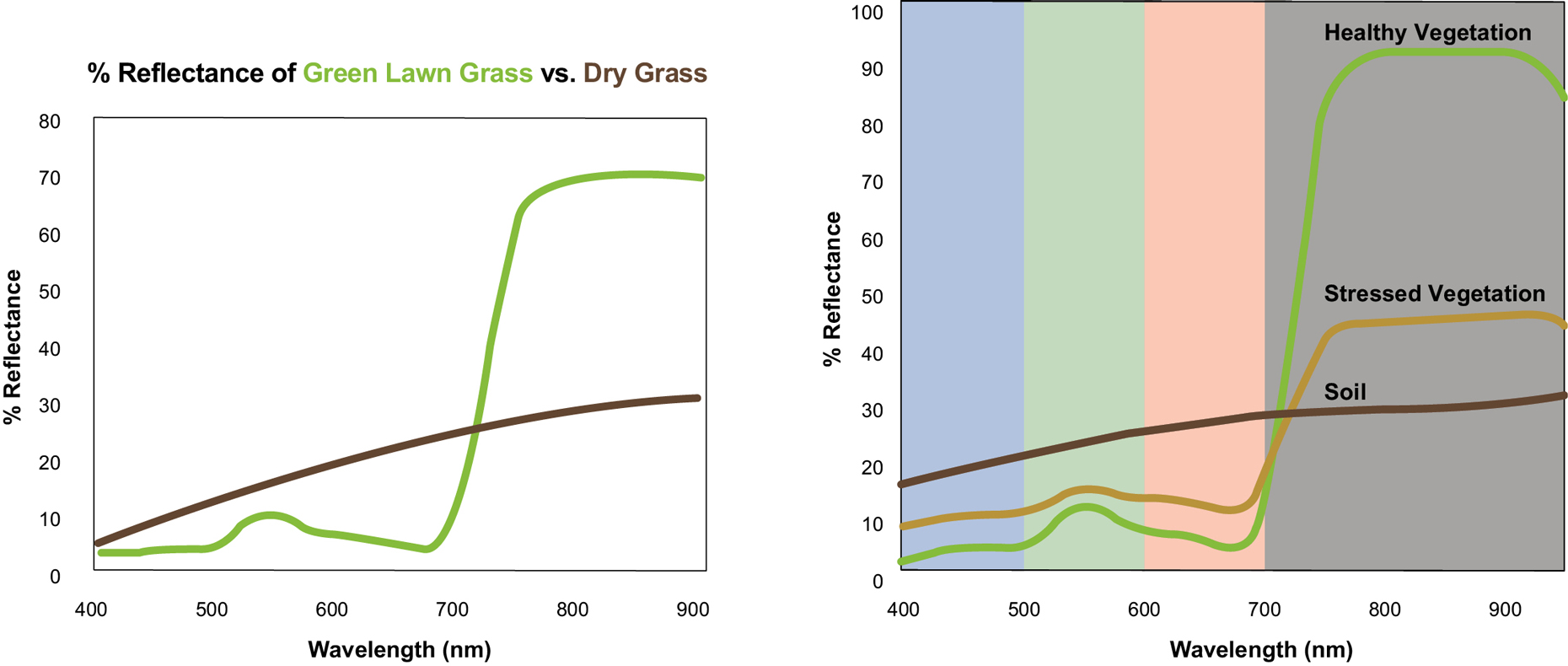NDVI / Agricultural Inspection
Dual Bandpass Filters and color cameras are becoming increasingly popular in agricultural and forestry applications for process control, mapping and vegetative health.

To analyze and differentiate healthy vegetation from stressed vegetation and background information, a widely used indicator known as the Normalized Difference Vegetation Index (NDVI) is applied to each image pixel. NDVI numbers are found by comparing reflectance differences in the near-infrared (IR) and visible spectrum using this equation:
NDVI = (NIR – VIS)
(NIR + VIS)
Traditionally, red light is used to represent activity in the visible spectrum. The logic behind this is that healthy, growing, green vegetation must produce needed energy through photosynthesis. When plants are actively photosynthesizing, they reflect or scatter near-IR light. Absorption of these wavelengths would result in overheating and tissue damage. The visible portion of the spectrum is absorbed; however, a little more green light is reflected away, relative to blue and particularly red light.

This accounts for the greenish coloring we see in foliage. But when plants are stressed or dying, photosynthesis slows down or stops. IR wavelengths are absorbed, while more visible light–particularly red light–is reflected. This is exemplified by the graph showing spectral reflectance of a healthy green lawn versus unwatered, dried out grass. Also, in the case of high altitude imaging, atmospheric scattering of blue and green wavelengths has favored the use of red and near-IR light.
When using two cameras or sensors and appropriate optical filtering, getting accurate red and near-IR data is straightforward. However, to reduce the weight and cost of systems used to gather NDVI information, and with the recent proliferation of relatively inexpensive unmanned aerial vehicles (UAVs) and small, lightweight cameras (such as IR-converted digital consumer cameras), interest has grown in single camera designs using new algorithms. There has been a push to make this technology more accessible, but consumer cameras are mainly designed according to artistic tastes and typically have poor color band separation and limited dynamic range. However these cameras can be highly affordable, and with the help of inexpensive dual band filtering, single camera NDVI (or similar) imaging is now low cost and the potential benefit to small-scale farmers, consumers and smaller organizations is being realized.
Many successful recent studies use traditional absorptive filters for monitoring plant health or vegetation cover, such as Kodak Wratten 25A (a red/near-IR longpass filter) or Schott BG3 (a blue/near-IR dual band colored glass filter), together with IR or mixed-spectrum converted digital cameras. These cameras start with an integral Bayer color filter array, consisting of separate blue, red and green filtering, over standard silicon-response pixels/sensors. But each of these RGB filters also transmit significant amounts of IR light. For this reason, all color cameras are also equipped with an IR blocking filter that is mounted over the sensor.
Because it is necessary to remove this IR filter for NDVI imaging to be possible, the results obtained with each camera can differ significantly. Regardless, the red Bayer longpass filter will usually pass both red and near-IR light equally well, so it becomes difficult to separate the two wavelength ranges and accurately calculate NDVI. Additionally, most of these cameras employ RGB-optimized auto exposure and auto white-balancing features that are not user controllable. Once the IR blocking filter is removed and IR light is allowed to reach the sensor, the camera can’t adjust to what has happened and the resulting overlapping in sensitivity of the channels, particularly because of the near-IR light present in each channel, and remixing of color balance often inhibits conversion of the results into meaningful NDVI values.

There are important advantages to using cameras that allow for manual white balancing and exposure control. Using different color indices and supporting filtering can also yield promising results. The graphic above shows images obtained using an IR-converted camera with (a) a red/near-IR longpass filter and (b) a blue/near-IR dual bandpass filter. In “b,” blue is substituted for red in the NDVI calculation. While using this type of dual band filter allows for greater band separation and overcomes some of the dynamic range issues, contrast and the resulting NDVI values aren’t as easy to work with as those obtained using red and near-IR data. In this case, the filter used was very broad band, with gentle cut-on and cut-off slopes.
Instead, a narrower, better positioned dual band filters with sharper cut-on and cut-off slopes (either blue/near-IR or red/near-IR) have proven to perform well when used in converted digital consumer cameras. Depending on the camera being used, in some cases performance of a single dual bandpass filter will approach that of a far more costly multi-spectral imager.

